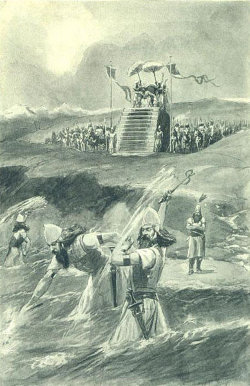
In the fifth century B.C., a storm upset the pontoon bridges by which Xerxes’ armies were crossing from Persia into Greece. Xerxes punished the strait with three hundred lashes. (Herodotus called this a “highly presumptuous way to address the Hellespont.”)
In the ancient Athenian summer festival known as Buphonia, an ox was slain with an ax, which was then charged with murder and thrown into the sea.
In 1428 Pope Martin V ordered English theologian John Wycliffe’s 44-years-dead body to be dug up and burned for heresy.
In 1519 a group of field mice in Stelvio, Italy, were charged with damaging crops by burrowing. The prosecutor argued that the loss of income prevented local tenants from paying their rents. The mice were assigned a defense attorney, Hans Grinebner, who claimed that his clients aided society by eating insects and enriching the soil. The judge banished the mice but promised them safe conduct and “an additional respite of fourteen days … to all those which are with young and to such as are yet in their infancy.”
In 1685, after the revocation of the Edict of Nantes, the Protestant chapel at La Rochelle, France, was condemned to be demolished. Its bell was spared, with a condition:
To expiate the crime of having rung heretics to prayers, it was sentenced to be first whipped, and then buried and disinterred, by way symbolizing its new birth at passing into Catholic hands. Thereafter it was catechized, and obliged to recant and promise that it would never again relapse into sin. Having made this ample and honourable amends, the bell was reconciled, baptized, and given, or rather sold, to the parish of St. Bartholomew.
— James George Frazer, Folk-Lore in the Old Testament, 1918
(Thanks, Brody.)
